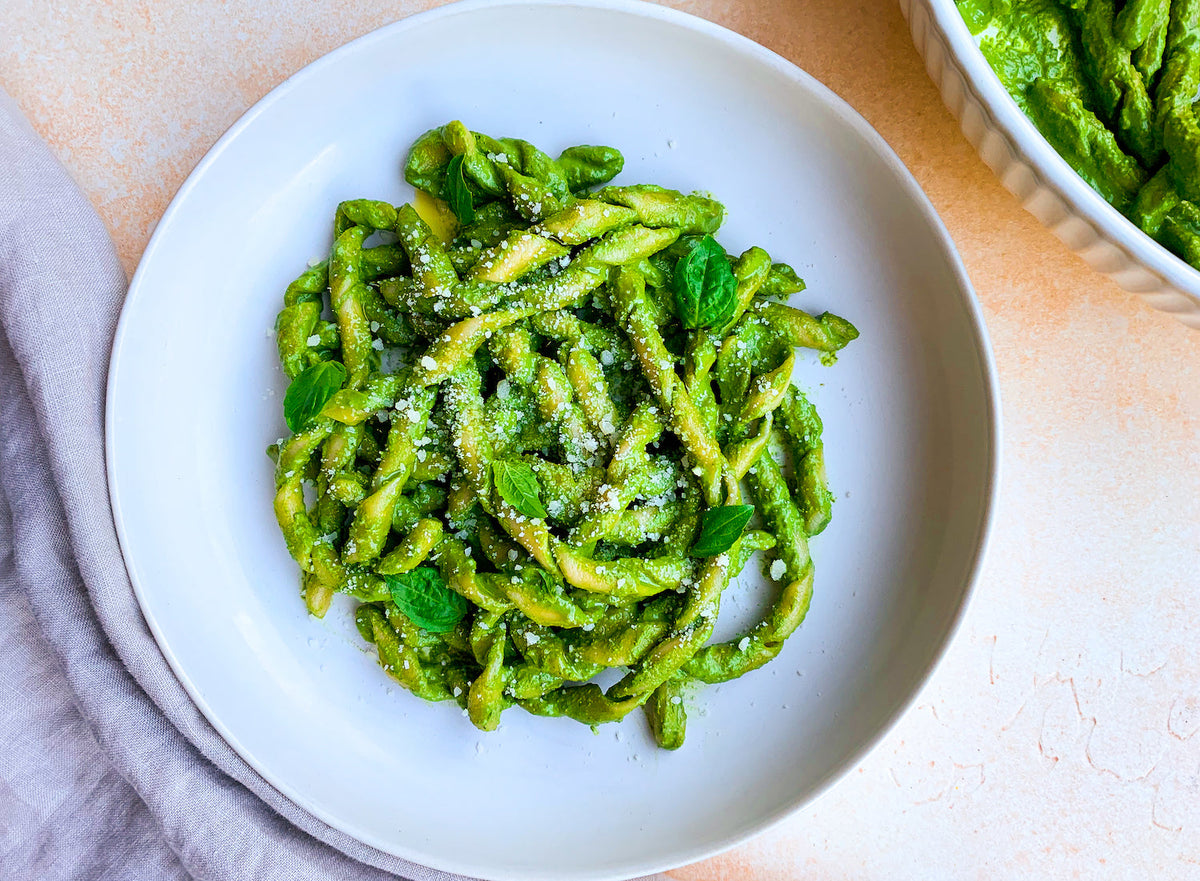
Busiate with Radish Greens & Basil
|
|
Time to read 4 min
|
|
Time to read 4 min
Some historians consider busiate to be the oldest handmade Sicilian pasta, with records of its existence dating back over 1,000 years. Its signature spiral shape was once made by rolling the dough along a local reed, or busa, that was used for both pasta-making and knitting. Today, it’s traditional to use a long metal rod known as a ferretto to achieve the same corkscrew effect.
You’ll often find busiate served with pesto alla trapanese, a tomato- and almond-based condiment perfect for summer. I’ve switched things up by pairing some common pesto ingredients with leftover radish tops for a peppery punch—but don’t hesitate to use whatever greens and nuts you have on hand. It’s finished with a touch of ricotta and Greek yogurt, an addition inspired by Rosetta’s basil sauce in the Pasta Grannies cookbook, for a little added lusciousness.
Not sure what to do with the radishes? Here’s an easy and delicious appetizer idea: radishes with herbed butter.

3 Hours, plus resting
10 minutes
2-4
300 grams (about 2 cups) semolina or semola rimacinata flour
50 grams ( about ⅓ cup) spelt or other whole wheat flour (optional; you can replace it with the same weight in semolina or semola rimacinata)
175 milliliters (about ¾ cup) warm water
More coarse semolina or cornmeal, for dusting
50 grams (1 large bunch) radish greens, tough stems removed and washed thoroughly
50 grams (1 large bunch) basil leaves
20 grams (2 tablespoons) pine nuts
1 large or 2 small garlic cloves, roughly chopped
25 grams (2 heaping tablespoons) finely grated Parmigiano Reggiano
25 grams (2 heaping tablespoons) finely grated Pecorino Romano
40 grams (2 tablespoons) whole milk ricotta
30 grams (2 tablespoons) plain Greek yogurt or sour cream
80 milliliters (⅓ cup) extra virgin olive oil
Salt and pepper, to taste
Make the pasta dough by hand (see instructions for the “well method” here ) and knead it vigorously until smooth and firm, about 10 minutes. Alternatively, add the flour(s) and water to a food processor fitted with a steel blade. Pulse until the ingredients are evenly distributed and couscous-like beads of dough form. The mixture should come together easily when pressed. Transfer the dough to an (ideally wooden) work surface and knead for 5 to 10 minutes, until the dough is smooth (some creases are okay) and homogeneous in color.
Wrap the dough tightly in plastic wrap and allow it to rest at room temperature for 15 minutes.
Dust a baking tray with more semolina flour or cornmeal (or line it with a dry dishcloth) and keep it nearby. Cut off a quarter of the dough and re-wrap the remainder immediately.
On a clean wooden board (if you have one), flatten the section of dough with the palm of your hand. Then, with a rolling pin—or wine bottle!—roll the dough into a disc about 1-cm (½- inch) thick. Cut the disc into 1-cm (½-inch) strips.
Roll each strip into a thin rope, about the thickness of an udon noodle (a little thicker than pici ). Cut the rope into about 20-cm (8-inch) sections.
To shape the busiate, position each piece of pasta vertically on the board, at 12 and 6 o’clock. Then position the ferretto at a 45-degree angle toward the left-hand side so you’re left with an upside-down V. Holding the bottom of the ferretto loosely in place with one hand, begin to roll the other end toward you as if tracing a wide arc (the ferretto might scoot a little to the right). The pasta will naturally curl around the rod. Once you have a spiral, very gently roll it back and forth once or twice with the palm of your hand to flatten it a little. Then twist the ferretto to loosen the pasta and slide it off.
Place the finished busiate in a single layer on the prepared baking tray and repeat with the remaining dough.
Note: You can cook the busiate once you’re done shaping them, or let them dry for about an hour so they hold their shape a little better. To store the pasta for future use, freeze the baking tray with the busiate (uncovered) for about 30 minutes until solid. Then shake out the excess semolina or cornmeal and transfer them to a freezer bag or airtight container. When you’re ready to boil them, do so straight from frozen—no need to defrost.
Bring a small saucepan of water to a boil and fill a small bowl with ice water. Blanch the radish greens and basil in the boiling water for 10 to 20 seconds until wilted and vibrant in color. Immediately transfer them to the ice water to cool.
Combine the blanched greens and remaining ingredients in a blender and process until smooth and creamy. If needed, add a small amount of water or more olive oil to get the blender running. Transfer the sauce to a large mixing or serving bowl and set aside.
Bring a large pot of water to a boil and salt it well. Carefully drop in the busiate, shaking out any excess semolina or cornmeal, and stir briefly to prevent sticking. Cook the pasta until tender, about 3 to 5 minutes, or to your liking.
When the pasta is ready, transfer it directly from the water to the bowl of sauce with a slotted spoon. Gently stir to coat, allowing the hot pasta and its residual cooking water to warm the sauce.
Divide the busiate among bowls. Finish with a drizzle of extra virgin olive oil, more grated cheese, and basil leaves, if desired.
